The #1 question asked so far this year: “How was the 2003 show”? Answer: Great!
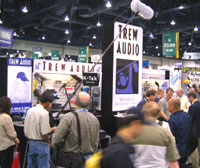
Non-linear Sound Recording Is Everywhere
At one time, at an NAB show about five years ago, the non-linear portable concept was a relative oddity. Correction: It was just plain odd. Lead by Zaxcom, with no other manufacturer even following, the Deva got the same looks from curious skeptics that the first computers probably received. The rest is history and the Deva is now leading a stampede, leaving tape in its dust like the plague. Now non-linear is everywhere, moving fast, and no one is looking back.
The Fostex PD-6
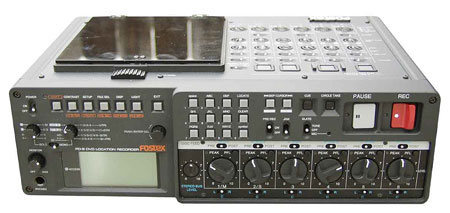
Available in its current software revision only a couple of days prior to the NAB show, feeling like I was cramming for a forgotten biology exam, I trudged through every feature, function, and option available on the PD-6 menus. Result: Didn’t find anything I couldn’t live with, and I couldn’t make it screw up.Recording a tone onto six channels, I shook, twisted, rotated, and even tossed it in the air a few times for about a full minute. When I played back the recording, it was as stable as if it were an analog Nagra full of D cells sitting on a sound stage.
Next, I quickly ejected and reloaded the mini DVD-RAM disk. It played back again perfectly, and half-way through the recording I pressed the record button. No problem (this is the start of what non-linear is all about).
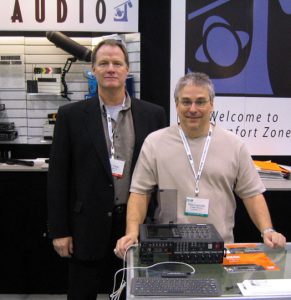 Glen and Fostex’s Rick Canatta stand behind the new PD6.
Glen and Fostex’s Rick Canatta stand behind the new PD6.Lack of safety in redundancy is one thing the skeptics bring up with the PD-6.
Well, it really needn’t be. By connecting the PD-6’s FireWire port to a notebook computer, a perfect copy can be made onto any device, such as CD-R, DVD-R, internal hard drive, DVD-RAM… whatever. Not sure about adding a notebook to your package? You mean you don’t already have a notebook? OK then, let’s do a little math: Selling price of the PD-6: ~$8500. Selling price of a competing product ready to go: ~$11500. The $3000 difference will buy one hell of a notebook computer that you can also use for other stuff even more exciting than recording sound.
How practical to transfer the PD-6 files to PC? Actually, not too bad. A 2-hour 2-track recording (a long day’s work back in the DAT days) can be transferred in just a few minutes. Worried about having a few minutes when break-off is called? No problem. It is a simple matter to transfer to the PC during the downtime between scenes, so that at the end of the production day there should be very little time needed to finish copying (probably less time that I used to spend labeling a DAT tape).
The only scary thing remaining is the reliability of recording directly to the 8cm DVD-RAM. The only thing that will increase the confidence level here is future history, but I haven’t been able to make it fail yet.
Taking the non-linear possibilities a step further than any other available competition, the PD-6 has the interesting and potentially very useful features called “4+2” and “5+1”. This refers to creating two separate files of the same recording; one mixed to one or two tracks and the other mixed to 4 or 5 tracks. The first use that comes to mind for this feature is recording a separate mix for dailies. For example, when only a mono mix is needed for dailies (or, hopefully, for the final mix), it can be transferred as the “+1” file, leaving the remaining “5” isolated tracks for future mixing if required. This feature saves bandwidth and transfer time when only the “+1” track is needed.
The 6-channel mixer section of the PD-6, in a word, is sweet. It is a very enhanced version of the 3-channel PD-4 mixer, and the PD-4 mixer proved to be demise of the competition 7 years ago. Enhancements to the mixer include low-cut slope selector for each channel (in addition to the PD-4-style low cut sweep), variable input trim (instead of the PD-4’s 0db, -15dB, and -30dB pad switches), pre/post fader track assignment switches plus L/R stereo buss assignment switches.
No need to wait for an after-market headphone monitor matrix (a la the early PD-4). The PD-6 has a complete monitor selection switch plus another switch for “soloing” your choice of recording track.
Lastly, the PD-6 has an available carry case made by PortaBrace, taking the familiarity trump one step further.
The Deva 5

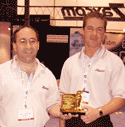
Glenn Sanders and Howie Stark with their Academy Award for the Deva recorder.
After four years of increasing success stories, a long list of acclaimed productions, and an Academy Award for the Deva II, Zaxcom, with the competition now hot on their trail, gave a sneak preview of the new ten-channel Deva 5 with a working prototype. An instant eye-pleaser with its large, color touch-screen, a closer look was even more impressive as Glenn Sanders gave a tour of the Deva 5’s capabilities. Briefly: 10 record channels, 16 inputs, record while playing, very intuitive menu that will even have a “help screen”. Those familiar with the Zaxcom Cameo mixer will immediately notice, and appreciate, the seemingly endless possibilities of signal routing. It is more accurate than not to say, “If you want it, you can do it” with the Deva 5. With the generous upgrade program offered by Zaxcom to Deva II owners, the success of the Deva 5 is already guaranteed.
The “New” Nagra 5
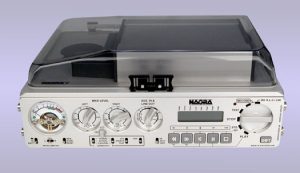
Nagra also debuted what was possibly the most overlooked item in portable recording at NAB 2003: The companion 4×2 stereo mixer (2 mic, 2 line). This mixer is at least as much a work of art as the recorder, and not only turns the Nagra V into a 6 input recorder, but also has a USB port for recording directly onto a PC computer (“excuse me… I left my recorder at home… is there a PC in the house? (of course there is!)). Sure to keep the hearts and minds of Nagra lovers (and who isn’t one?), the mixer is every bit the piece of jewelry that its predecessors were.
Aaton Cantar
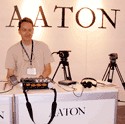 The new Cantar was displayed at the Aaton Booth.
The new Cantar was displayed at the Aaton Booth.This portable hard disk recorder in an incredible piece of work. Subtly paying tribute to Nagra styling, the physical machining and design alone may be enough to win the hearts of some. But that’s only the beginning.

Scheduled availability: September 2003.
The HHB PortaDrive

The PortaDrive records up to 8 channels to an internal hard drive with broadcast wave files (.BWF) and can make copies via its external SCSI port. HHB is optimistic that delivery can be as soon as this summer.
Sound Devices Hard Disk Recorder
Sound Devices, best known for their high-quality portable mixers, stunned the world with a preview of their miniature hard disk records. About the same size as the USB Pre, the recorder will be available in a two track, non-timecode version called the 722 and a four track timecode version called the 744T. Not a company to wait around for anyone, these recorders are to be available this summer.
K-Tek General Purpose Mount with Spider Suspension
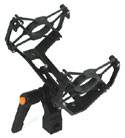
An original concept and design, it uses two one-piece rubber “spider” suspensions, each attached at four-points on the frame.
A notched adapter is available for use inside Rycote Suspensions. Exceptionally light weight.
K-Tek Plug-On Transmitter Protector

This sturdy cage attaches to the end of the boom pole and surrounds the transmitter.
Cooper CS208 Keeps Getting Better
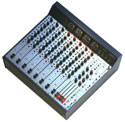
Available now as an option are high quality 24 bit A/D converters for optimum interfacing with digital equipment. The converters offer complete selections of bit depth, sample frequency, .1% pull-up/down, external sync from word clock, video, or AES. The result is a mixer closer to the routing capabilities of a full digital console with the rock-solid stability of the legendary analog Cooper consoles. Well done. Availability: Now!
Sanken CS-1 very Short Shotgun Microphone
Who makes short-shorts? Well, now Sanken does! With a sneak peak at the Sanken booth it was observed that this microphone has several points that guarantee its success.
The mic is about 30% shorter than a Sennheiser 416, has about the same pickup pattern as the Schoeps MK-41, but once you are “off of the pattern” the rejection from the sides and rear are as extreme as the CS-3 (extreeeeme). Amazingly, the rejection at 200Hz is about the same as it is at 10kHz. Off-axis, even the low freq rumble of a generator disappears.This means that two microphones in your kit, the CS-3 and the CS-1, can actually cover the range of overhead boom applications that have traditionally required three or more. The price is below $750, which is way below anything else in its class.
Now here’s some investment tips for the money you’ll have left over:
Sennheiser 418S Microphone
Realizing that the 416 will always be a great microphone, Sennheiser further immortalized it with the 418 M/S stereo shotgun microphone. Basically a 416 with a figure-of-eight element built in, and the same physical dimensions it’s a great way to do stereo without having to add new suspensions and wind protection.
Sennheiser 816 limited Re-release
It’s baaaaaaack! Nothing can reach out and touch someone quite like the Sennheiser 816 long shotgun.
According to reliable sources, someone new in sales ordered a batch of these discontinued mics and the order was received by someone new in production who went ahead and built them! Get them while they’re hot – it probably won’t happen again.
Lectrosonics MM400A Compatibility with Shure, Sennheiser, & Non-Hybrid
We’re smack in the middle of the digital age, and Lectrosonics has plenty to offer to keep their 90% market share up to date. Their flagship 400 series “Digital Hybrid” offers significant advantages over the vulnerable 211 series. They are an improvement in sound quality due to the absence of an analog companding circuit. There is no “pumping” or “fluttering” or “fshhhhffft” to be heard with the 400 system.
It’s digital processing power can even be used to emulate other brands, making them compatible with competing manufacturers. According to Lectrosonics, the 400 series transmitters sound better that the brand XX transmitters, even when using the brand XX receivers. In short, the 400 series offers advantages of digital processing with the superior range of analog transmissions.
Lectro also showed their miniature waterproof transmitter, now made of aluminum, much lighter than the original stainless steel version. Based on the 400 digital hybrid, it can be setup for use with either the 400 or 200 series receiver, or even for use with Sennheiser receivers.
Ambient Emesser
The Ambient Emesser turns any directional microphone into a Mid/Side stereo rig. The set consists of a miniature figure-of-eight microphone, a piggy-backing clip, and a connecting harness.
All you do is mount the small figure-of-eight on top of your existing “mid” mic (such as a Sennheiser MKH-60 for example), and then plug the three pin XLR connector of the supplied harness into the “mid” mic. The remaining connector of the harness is a stereo standard 5 pin XLR, which is then connected to your mixer or recorder.
The advantages of this system over an all-in-one microphone can be several. First, if you already have a suitable microphone, adding the Emesser is less expensive. Second, You can move the Emesser to the microphone of your choice. For example, you can use it on a short shotgun and then move it to a hypercardioid when you prefer. Lastly, the same zeppelin style wind protection normally used for your “mid” microphone can be used when the Emesser is attached. Top notch Ambient quality.
Ambient Tri-Level Lockit
A logical progression in the series of Ambient timecode and sync products, the Tri-Level Lockit is specifically designed for High Definition video production. High Def cameras do not use the same type of sync-locking signal that traditional video equipment uses. Plus, since High Def cameras are often used in the film-style tradition of having no cables attached, a hardwired sync and timecode source is not practical, and “free wheeling” without sync lock just will not do.
A pocket-sized Tri-level Lockit box properly set and attached to each camera will keep them running in phase-lock accuracy with matching timecode. Each time these boxes are set from the master generator (Ambient XXXXX), they can be recalibrated to within 10ths of a frame per day.
Taking it even a step further, an interface is available to calibrate the master generator to the GPS (global positioning system) atomic clock, allowing synchronizing of cameras even when they are on different continents.
Denecke SB-T Tri-Level SyncBox

Denecke introduces the “SB-T” (tri-level) SyncBox. With standard BNC connections for timecode and sync, and a 4-pin Hirose for external power, there is a Lemo connector option for using cables made for Ambient Clockits.
True to the Denecke style of ultra-rugged construction, simplicity, and ease of use, the SB-T supplies dead-on accurate timecode and sync signals for High-Def (both 1080 and 720), NTSC, and PAL formats, with every conceivable frame rate, including 23.976.
The SB-T maintains sync for over 48 hours with 3 AA cells, and with the temporary help of external power, batteries can be changed without loosing sync or timecode.
Sony ECM-88 Lav Mic
Leave it to Sony to do something different. Carrying the fine tradition of the ECM electret condenser mic series, the ECM-88 has openings front and rear, but one can be completely covered and it make no difference. Possibly the best-kept secret in miniature microphones today (but that’s bound to change soon), for all practical purposes there is no cable noise (none, zero, nada, zilch), and it sounds at least as good as any other.
Remote Audio “Speak Easy”

The Speak Easy is a small monitor speaker with an internal amplifier that operates from an internal 9-volt battery. Everyone was impressed with the sound quality, but the real surprise was the loudness possible from a 9-volt battery. Another key part in getting so much attention was the built-in connections for a +4dB balanced input signal on 3-pin XLR, and a –10dB unbalanced input signal on RCA.
Built primary for monitoring and communication on a film set, everyone seemed to have different ideas of their own, including remote broadcast off-air monitoring and a companion monitor for field editing notebook systems. Price: $179 through May, 2003.
– – Glen Trew
For more information on these and related items:
- Deva II: http://www.trewaudio.com/articles/deva/
- Nagra 5 and Deva II:
https://www.trewaudio.com/articles/deva-ii-and-nagra-v/ - Speak Easy:
https://www.trewaudio.com/product/remote-audio-spkezv3bwmp/


 US
US  Canada
Canada
Leave a reply
You must be logged in to post a comment.